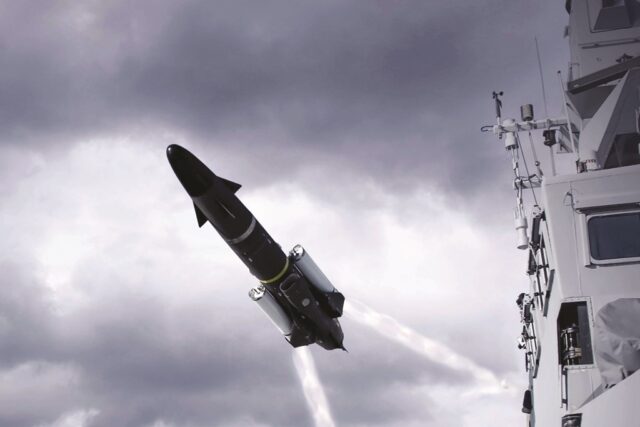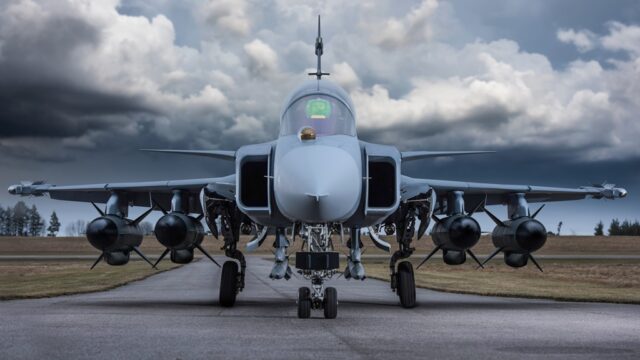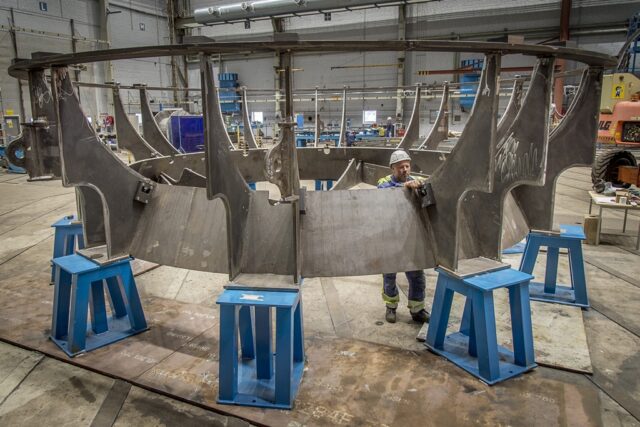The planned development of the combat potential of the Polish Navy in the form of the purchase of three frigates under the “Miecznik” program and the re-arming of the ORP Ślązak patrol ship and making it a fully-fledged corvette made it possible to visit the Saab stand during MSPO 2022. From the representatives of the Swedish company, it was possible to find out about the RBS15 missiles and the Swedes’ view on the issue of new Polish submarines.
RBS15 for “Miecznik”
Already in March, the Armaments Agency partially informed about the configuration of the weapons on the new frigates. The main criterion when choosing the armament and sensors was the righteous desire to unify the systems with those already in use on other Polish ships. Therefore, the main anti-ship armament will be the Saab RBS15 missiles, which are already present on small Orkan-type missile ships. Ordering parties still have to decide whether to stick to the RBS15 Mk3 version or choose the more modern RBS15 Mk4 variant.
-ADVERTISEMENT-

The RBS15 Mk3 missiles can be used both in coastal waters and in the open ocean, and new in this version is the ability to attack land targets. In this case, however, the selection of targets is limited to fixed objects, since the guidance is carried out with the help of satellite navigation, so the position of the target must be known before firing. The range is over 200 kilometers.

RBS15 Mk3.
(Copyright Saab AB)
The combat load is a 200 kg fragmentation warhead. In order to break the enemy’s defenses, the RBS15 Mk3 uses a combination of several systems. Electronic anti-jamming means (ECCM) have been installed on the missile, the flight path runs just above the sea surface (sea skimming, two meters above the waves), the missile can make random, abrupt changes in course, and in the last phase of the flight, thrust increases. The maximum speed is Mach 0.9. Before firing, several turning points in three dimensions can be set along the missile route. The missile is guided by active radar. It is a fire-and-forget weapon.
The RBS15 Mk4 was commissioned by the Swedish Air Force. Although there was a version of the RBS15F ER that was the airline equivalent of the RBS15 Mk3, the Swedish Air Force wanted a lighter missile, which allowed the JAS 39E Gripen to carry four rather than two rounds. Its development began in 2017, and a year later the missile was presented at the fair in Farnborough. You can sometimes come across the RBS15 Gungnir designation, but it’s confusing. The name (derived from the god Odin’s spear that always hits the target) means the entire system, sea, air or land respectively, but the missile itself is RBS15 Mk4.
Both missiles have the same dimensions: length 4.35 meters, hull diameter 0.5 meters and a span of 1.4 meters. Both share the same guidance system and achieve the same high subsonic speed. The differences are apparent in weight and range. The RBS15 Mk3 weighs 660 kilograms and 820 kilograms together with the starter engines, and in the case of the RBS15 Mk4 the weights are 650 and 810 kilograms respectively. The difference is small, but with the Gripen E’s increased payload relative to the Gripen C, it allowed the fighter to carry four rounds.
Due to the identical dimensions, the Mk3 and Mk 4 missiles can be fired from the same launchers, so if Poland purchases the RBS15 Mk4 they could be successfully used in Riptides. As for the range, in the case of the Mk3 version it is around 200 kilometers, and in the Mk4 version – over 300 kilometers.
In addition, the new missile uses a more modern GPS receiver with an anti-jamming system and an inertial navigation system that allows for effective impact execution even in the absence of satellite navigation. A coordinated attack with a salvo of several missiles that will reach the target at the same time from different directions is possible. In addition, if you miss the target in the first attack, the projectile can turn back and make a second attack. If the target is not found, it will self-destruct.

The RBS15 Mk4 missiles have a range extended to over 300 kilometers.
(Copyright Saab AB)
In connection with the selection of RBS15 for “Miecznik”, Saab and Mesko signed a cooperation agreement regarding the possibility of establishing a missile service center in Poland. The aim is to define the terms of cooperation in establishing Mesko’s RBS15 serviceability. The agreement defines the areas of cooperation, including training for operators and technical personnel, technical and service support for missiles and on-board systems. The agreement includes the possibility of establishing an RBS15 recertification, servicing and repair center in Poland.
– Saab, as a supplier of RBS15 for Orkan missile ships, has been supporting Poland’s security for many years, said Stefan Öberg, Saab’s vice president and head of the missile systems department. – We are proud that our system has been appreciated by the user and chosen for the new “Swordfish” frigates. Given the current security situation in Europe, this significant enhancement of naval capabilities makes the creation of a local support center for RBS15 systems even more important.
The signed agreement does not mean the immediate creation of a service center, but is an expression of the intentions of both parties. The final shape and scope of cooperation as well as the scope of works performed by Mesko will be determined after analyzing the technical capabilities of the Polish plant.
Interview with Jyrki Kujansuu, president of Saab Technologies Poland
What can you say about the contract signed with Mesko?
First of all, we should start with the fact that we believe that the technical support of a given system, for many reasons, should be provided in the user’s country. Of course, we can perform these services at our facilities in Sweden, but it is better to find a local partner and just make sure that the work is done properly.

JAS 39E Gripen with four RBS15 Mk4.
(Hans Berggren; Harleys, Copyright Saab AB)
The cooperation agreement means that we have found a potential partner who is interested in working with us and now we have to work out the terms of cooperation. We cannot come with a ready offer and say: sign here. We have to adjust the terms of cooperation to the local partner. At the same time, we are negotiating the terms of the contract for the delivery of missiles for “Miecznik”.
It is known that there will be RBS15 Mk3 or Mk4 missiles on “Mieczniki”. What’s the difference between them?
There are some major differences. The first is range, the Mk4 has a greater range. In addition, the Mk4 can be easily integrated with aviation platforms. In fact, the RBS15 Mk4 was designed to be integrated with airplanes. In addition, the end result of the use of the bullet is, so to speak, increased. These are the two main differences, but there are also a few that are secret, and I can’t talk about them.
Can you tell us about the other news about RBS15?
We are pleased that Germany has decided to continue using these missiles. This is advantageous because it is an allied navy and thanks to the same weapon systems, more effective joint exercises can be organized, for example, with the exchange of crews between the ships of both countries. For us, the German Navy is a key customer that we can boast about. We can see several direct and indirect advantages to both fleets using these missiles.
Will Saab, which also produces other marine equipment, be involved in the “Swordfish” program in any way other than RBS15?
At the moment, work is underway on the final configuration of the ship, but we do not have any special hopes. The Polish Ministry of Defense decided to bet on the British offer based on the Babcocka ship, with Thales as the supplier of the combat control system. There are discussions about the suppliers of several other elements, but it is too early to say what they will end with. The final technical project is to be ready by the end of the year and then we will find out.

Production of elements of the A26 submarine.
(Pettersson Glenn, Copyright Saab AB)
I would now like to ask about submarines. What is the status of the Plowing program today from Saab’s point of view?
Minister Błaszczak maintains that the Orka program is still included in the current technical modernization program. For us, this means that the program has not been canceled. So we are waiting for it to reboot, we are ready and when it reboots I can guarantee Saab will be able to compete. I believe that our offer is technically and economically very good.
Will Saab make any offer of industrial cooperation in connection with the “Orka” program?
Of course, we will prepare a huge offer of industrial cooperation. We have already run this campaign once. We made our offer back in 2017, then the program was put on hold, but when it is restarted we will not start from scratch. Everything will depend on the final customer requirements, but if they are based on what was in 2015-2017, we are able to quickly prepare our offer and sit down at the negotiating table. We already have many partners in Poland with whom we cooperate on other projects.
What is the status of the A26 submarine construction program now?
The A26 is in full production. In the spring, I was in the shipyard and saw rapid progress in construction. Coming back to “Orka”, if Poland decides to choose the A26 within a few years, it will fit perfectly into the production plan of the shipyard, which now produces ships for Sweden and will have a free production line ready.
Thank you for the conversation.
See also: Japan strengthens forces against China
Copyright Saab AB

